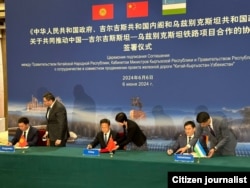Amid Ukraine Fallout, China Pushes Ahead With Bold Kyrgyzstan Trade Vision
- By Kubatbek Aibashov and
- Chris Rickleton

BISHKEK, KYRGYZSTAN -- A Swedish consultancy group made international headlines in 2007 when it declared that Santa Claus should be based in Kyrgyzstan, as it was the best place for him to reach every household in the world during his fabled Christmas-night journey.
For those restricted to ground travel, however, landlocked Kyrgyzstan still looks like a logistics nightmare with its soaring mountain peaks and poor roads.
Yet China is undeterred and seems to be pulling out all the stops to turn Central Asia's second-poorest country into its next big project in terms of trans-Eurasian trade.
In a world reshaped by geopolitical turbulence -- and having suffered false starts with China in the past -- Kyrgyzstan will be hoping that this commitment is here to stay.
A $4 Billion Logistics Hub?
October came and went without promised construction work beginning on the China-Kyrgyzstan-Uzbekistan railway: a long-promised, multibillion-dollar megaproject that optimists say could transform East-West trade, cutting delivery times between China and Europe by up to one week.
But there were other significant groundbreakings in Kyrgyzstan last month, and many of them involved China in one way or another.
The most eye-catching and perhaps mysterious was the construction kick start of the Manas Trade and Logistics City in Leninskoye village, not far from the capital, Bishkek.
The trade-hub project will be built by the Hunan Construction Investment Group (HCIG), with its first phase alone costing $700 million and the overall cost potentially reaching $4 billion.
Set on 700 hectares, the project will have dedicated zones for storage, logistics, sales, and bonded trade zones.
Does this project have a special connection to the future railway?
Yes indeed, say Kyrgyz officials.
Except none have yet really explained how, and the track agreed to by the three participating countries is not expected to skirt anywhere near Leninskoye, taking instead the shortest route through deeply mountainous territory. In fact, Leninskoye is on the border with Kazakhstan, close to Kyrgyzstan's existent north-pointing railway.
If Beijing knows more, it's keeping its cards close to its chest.
Speaking at the ceremony on October 17, Chinese Ambassador to Kyrgyzstan Du Dewen praised Kyrgyzstan as "a connecting country" that is "not only important to Central Asia, but also to Asia and Europe as a whole."
Du said that, since the long-stalled railway project was going ahead, Kyrgyzstan would also need "good markets, warehouses, and logistics centers," and hailed the logistics hub as a project in line with China's Belt and Road Initiative, but gave no indication of how it might interact with the track further south.
Planning for the future hub began on December 8, 2023, when Kyrgyzstan’s government signed an agreement with the Kyrgyz-Chinese Investment Holding (KCIH) company to build a "Eurasian trade and logistics complex."
Despite the rebranding -- Manas is a mythical Kyrgyz hero -- Kyrgyzstan’s cabinet will only have a 49 percent share in the project, with KCIH taking the remainder.
A little-known entity founded by Chinese nationals but including Kyrgyz directors, KCIH will be responsible for $482 million of the $700 million investment.
Never Mind The Competition
Making his own speech at the groundbreaking, Kyrgyz Prime Minister Akylbek Japarov (no relation to President Sadyr Japarov) said the logistics center "can be compared to a major seaport."
"Everyone in the world wants to trade with China, because if you look at the volume of global GDP, China produces up to 26 percent of it. We hope this will give us access to maritime routes and enable us to trade with any country in the world," Japarov said.
"This will create excellent conditions for our agriculture, manufacturing, mining industry, and for the arrival of new technologies."
For the moment, Central Asia's largest and most advanced "dry port" is Khorgos on the Chinese-Kazakh border.
Khorgos is a vital node in East-West train freight, with goods still overwhelmingly reaching Europe via Russia.
The Ukraine war and pursuant sanctions have, however, made some shippers leery of the Russian route.
That has provided a giant shot in the arm for the Trans-Caspian International Transport Route (TITR), also via Kazakhstan, with the oil-rich country's Caspian Sea ports providing the jump-off points for goods traveling to Europe via the Caucasus.
If the TITR would exclude Russia, the China-Kyrgyzstan-Uzbekistan railway would potentially exclude Kazakhstan, too, joining up with existing tracks in Turkmenistan and Iran to reach markets in the Middle East as well as Europe via Turkey.
Supporters claim it would be a much faster route to Europe than both, although it is not clear to what extent their calculations take in the greater number of border crossings that this southern middle route would have to contend with.
Russia has previously been viewed as something of a roadblock for the project.
But as a Foreign Policy Research Institute paper published earlier this year argued, Moscow's ability to push back against initiatives like these has been constrained by its need for China's support amid fallout from the Ukraine war.
This "has given Beijing a freer hand to reshape Central Asian trade flows," author Felix K. Chang wrote.
For all that, the three-country railway would be arguably more ambitious than anything China has done in the region, including the 1,800-kilometer Central Asia-China gas pipeline reaching Turkmenistan, whose first spur took just two years to build.
And with the 260-kilometer Kyrgyz section of the track requiring a series of high-altitude bridges and tunnels, very few people will share Prime Minister Japarov’s optimism that it will be finished in four to five years.
Special Economic Zones, Unite!
Given that China is currently responsible for more than half of the minimum $5 billion financial commitment for the track -- $8 billion is the Kyrgyz government's latest estimate -- might Beijing walk away if geopolitical trends shift again?
For the moment, that looks unlikely.
In his latest update on the railway, Prime Minister Japarov said President Japarov had held discussions with Chinese leader Xi Jinping on the project on the sidelines of the BRICS summit, an event that was held in the Russian city of Kazan on October 22-24.
He added that construction was now expected to begin in November -- a month later than the Kyrgyz president predicted in May.
Fittingly, Kyrgyzstan's prime minister was making those comments during a work trip that was full of Chinese activity.
One of his appearances was for the groundbreaking ceremony for a residential complex that a Chinese company is building in the city of Naryn.
At another he turned a shovel for the construction of four Chinese-built plants in an industrial park that he said will create more than 1,000 jobs.
The industrial park is benefiting from long-term but intensifying cooperation between the Naryn Special Economic Zone (SEZ) and the much larger SEZ in the Chinese city of Kashgar, in Xinjiang.
Prime Minister Japarov visited the Kashgar SEZ in March, some three months after the two entities agreed to deals that included the shared use of warehouses in each country.
Of the four plants being built in Naryn, a car-assembly plant will provide the bulk of the jobs, while three others will produce LED lamps, toilet paper, and agricultural technology, respectively.
Nearly five years ago, Naryn Province, which the railway would traverse, was the scene of a major Chinese investment failure, as local unrest scuttled plans as local unrest scuttled plans for a logistics center that would have been more modest than one that is being built in the neighboring Chui Province.
At that time, China's BRI looked to have hit a bump in Beijing's unrest-prone neighbor. Now it is back on track.

















